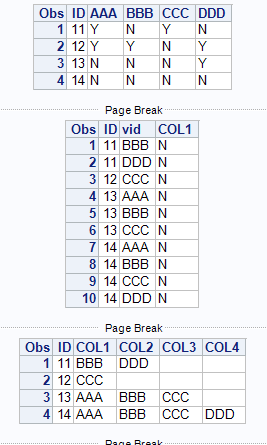- Home
- /
- Programming
- /
- Programming
- /
- Re: get required column names
- RSS Feed
- Mark Topic as New
- Mark Topic as Read
- Float this Topic for Current User
- Bookmark
- Subscribe
- Mute
- Printer Friendly Page
- Mark as New
- Bookmark
- Subscribe
- Mute
- RSS Feed
- Permalink
- Report Inappropriate Content
Hi,
I want all the 'N' varibales and their id's
data have;
input ID AAA$ BBB$ CCC$ DDD$ ;
cards;
11 Y N Y N
12 Y Y N Y
13 N N N Y
14 N N N N
run;
want:
11 BBB
12 CCC
13 AAA BBB CCC
14 AAA BBB CCC DDD
- Mark as New
- Bookmark
- Subscribe
- Mute
- RSS Feed
- Permalink
- Report Inappropriate Content
input ID (AAA BBB CCC DDD)(:$1.);
cards;
11 Y N Y N
12 Y Y N Y
13 N N N Y
14 N N N N
;;;;
run;
proc print;
run;
proc transpose name=vid out=have2(where=(col1='N'));
by id;
var aaa--ddd;
run;
proc print;
run;
proc transpose out=want(drop=_:);
by id;
var vid;
run;
proc print;
run;

- Mark as New
- Bookmark
- Subscribe
- Mute
- RSS Feed
- Permalink
- Report Inappropriate Content
Please also try alternativey
data want;
set have;
array new(4) AAA BBB CCC DDD;
do i = 1 to 4;
if new(i)='N' then new2=vname(new(i));
if new2 ne '' then output;
end;
run;
proc sort data=want nodupkey;
by id new2;
run;
proc transpose data=want out=trans(drop=_name_);
by id;
var new2;
run;
Thanks,
Jag
Jag
- Mark as New
- Bookmark
- Subscribe
- Mute
- RSS Feed
- Permalink
- Report Inappropriate Content
This might get you what you want. I put the dummy (id = 10) in their to keep the columns in order for the final output. Not exactly the presentation you have but it's close.
data have;
input ID AAA$ BBB$ CCC$ DDD$ ;
cards;
10 N N N N
11 Y N Y N
12 Y Y N Y
13 N N N Y
14 N N N N
;
run;
proc transpose data=have out=prep(where=(col1 = 'N'));by id;var aaa bbb ccc ddd;
proc transpose data=prep out=prep2(drop=_label_ _name_);by id;var _NAME_;
data want;
set prep2;
if id = 10 then delete;
run;
- Mark as New
- Bookmark
- Subscribe
- Mute
- RSS Feed
- Permalink
- Report Inappropriate Content
data want;
set have;
array vars aaa--ddd;
length temp $20.;
do i=1 to dim(vars);
if vars(i)='N' then do;
temp=catx(' ',temp,vname(vars(i)));
n=count(catx(' ',of vars(*)),'N');
end;
end;
call missing(of vars(*));
do j=1 to n;
vars(j)=scan(temp,j);
end;
keep id aaa--ddd;
run;
April 27 – 30 | Gaylord Texan | Grapevine, Texas
Registration is open
Walk in ready to learn. Walk out ready to deliver. This is the data and AI conference you can't afford to miss.
Register now and lock in 2025 pricing—just $495!
Learn how use the CAT functions in SAS to join values from multiple variables into a single value.
Find more tutorials on the SAS Users YouTube channel.
SAS Training: Just a Click Away
Ready to level-up your skills? Choose your own adventure.



